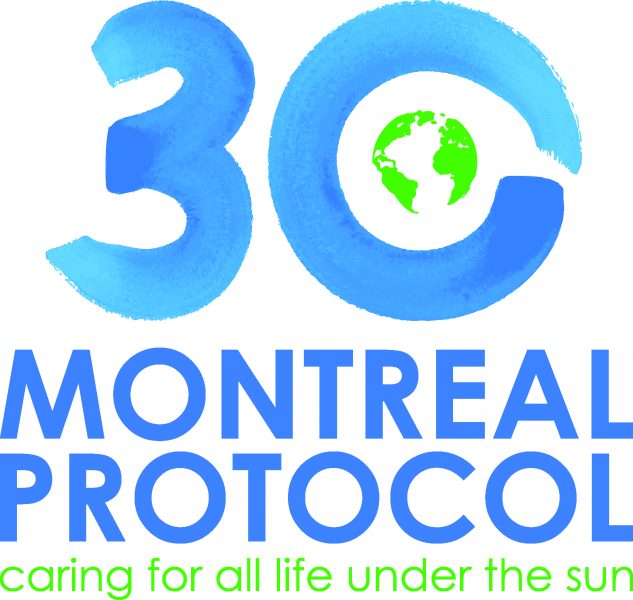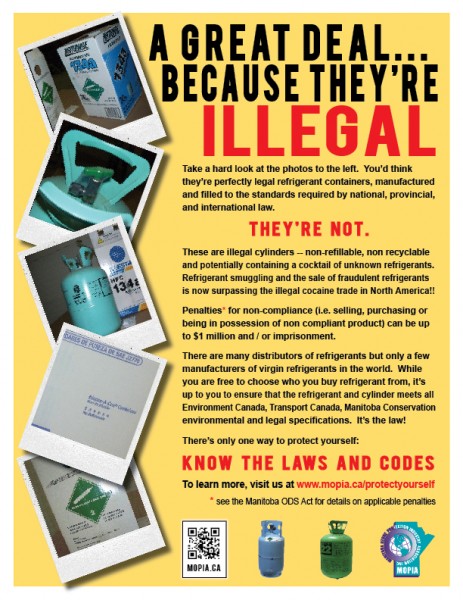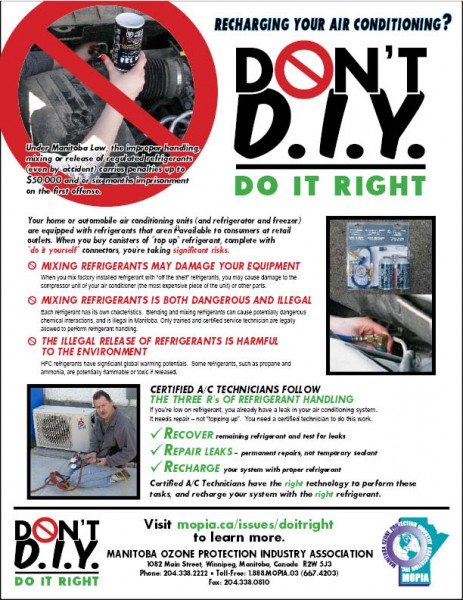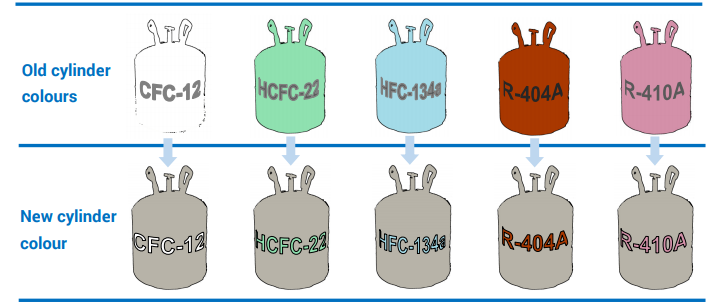Frequently Asked Questions
After you have successfully completed the MOPIA certification training, you are now required to pay an annual renewal fee every June 1st.
You can do so by cheque, cash (in office) or by simply calling MOPIA reception directly at (204) 338-2222, or by visiting our Renewals page and paying it electronically.
As a certified service technician you are now responsible for renewing your certification by June 1st of every year. Technicians must also mail, fax or email copies of their record datasheets annually by February 1st. These records should include the use of regulated substances for the period of January 1st to December 1st. In regards to leaks, the technician is responsible for the reporting of leaks both in their annual services records, but also if over 22 lbs. to Manitoba Sustainable Development immediately.
Compliance on the Manitoba ODS and Other Halocarbons Regulation, including enforcement is carried out by Manitoba’s Environment Officers with Environment, Climate and Parks.
If you have an ODP or ODS certification card issued from HRAI Canada, you qualify for a Manitoba certification card by contacting MOPIA directly. If you do not have another provinces certification, you will have to take Manitoba ODS certification training. See more on our Training page.
Visit MOPIA’s website and the various links throughout. The United Nations Ozone Secretariat (UNEP) and other government sources have extensive information, (i.e NASA, NOAA).
No, hydrocarbons refrigerants are not regulated, but are allowed to be used only after a system has the regulated refrigerant safely recovered. Adding a hydrocarbon (or other) type of refrigerant into a system that contains a regulated substances is creating a cocktail or mixture of refrigerants and is not permitted. Also refer to the original equipment manufacturers specifications as some systems may not work as effectively and/or damage the equipment when a different type of refrigerant is added. Extreme caution and knowledge is the best practice.
No, topping-up any regulated refrigerant (as per MR 103/94 – HCFC, HFC, etc.) is never permitted. A leak test is required before adding any refrigerant. Refer to Manitoba’s approved leak test procedure in our compliance guide.
The reason being releasing refrigerant(s) into the atmosphere may be harmful to the ozone layer, climate system or have other environmental impacts.
No, the automotive sector does not have a National stewardship program for refrigerants. Refrigerant Management Canada may offer service options if contacted. For more information please go to Refrigerant Management Canada.
Yes, you should be able to return the tank back to the place of purchase regardless if it is full or empty. Contact the place of purchase before you try for more details.
You can contact Refrigerant Management Canada at 1-(800)-267-2231 or at Refrigerant Management Canada.
You can contact an Enviroment Officer at 1-(204)-945-5305 or via contacts at Environment and Climate Change | Province of Manitoba.
Still Have Questions? Ask Us!
MOPIA is charged with the responsibility for not only the awareness of the environmentally handling of refrigerants to the various service industries.
We have held awareness sessions throughout Manitoba each Spring and Summer until 2020, due to COVID-19 restrictions.
We are once again pleased to offer awareness sessions across the province. See below for details and times:
MOPIA will be hosting our informative program awareness sessions across Manitoba. These one-hour sessions are designed to inform our stakeholders about any pending industry trends, new technology and regulatory awareness.
MOPIA spent the Spring and Summers of 2007 – 2019 touring Manitoba to deliver the facts to MOPIA’s trained technicians, as well. These were valuable opportunities to exchange ideas and share information with our stakeholders. MOPIA also heard concerns and issues from our members. 
The sessions included highlights of the regulation and information about MOPIA’s ongoing and upcoming activities.
The amended regulation took effect on March 9, 2006.
Following are some of the highlights of the regulation:
- Releases Prohibited- no person shall release or permit the release of a Class 1, 2 or 3 substance into the environment.
- When it comes to installation, service and repair- no person other than a trained service technician shall perform those duties.
- Use, disposal and storage of Class 1, 2 and 3 Substances- no person shall add a Class 1, 2, or 3 substance to any equipment for the purpose of leak testing the equipment.
- No recharging of portable fire extinguishing equipment.
- Class 1 permits and recharging permits are required for fixed fire extinguishing equipment.
- Permits will also be required for irreplaceable equipment- a person who operates a unit of fixed fire extinguishing equipment that uses a Class 1 substance may apply for a Class 1 permit or recharging permit.
- Prohibited releases from purge systems.
- Class 1 substances in Chillers- no person who operates a chiller shall use a Class 1 substance in it except under the authority of a Class 1 permit.
- Disposal of equipment- no person shall dispose of (a) air conditioning, fire extinguishing, refrigeration or other equipment; or (b) an object; that contains a Class 1, 2 or 3 substance without first ensuring that the Class 1, 2, or 3 substance is or will be recovered for recycling, reclamation or destruction.
- Storage of recovered substances- despite any other provision of this regulation, a person who recovers a Class 1, 2, or 3 substance shall, if the condition or quality of the substance is inadequate for reuse, recycling or reclamation, store or arrange for storage of the substance until it can be delivered to a person for destruction.
- Sale of fire extinguishers- no person shall display or offer for sale, sell or transfer to any person any fire extinguishing equipment that contains a Class 1 substance.
- Sale in inappropriate containers prohibited- no person shall display or offer for sale, sell or transfer a Class 1, 2 or 3 substance that may be used in air conditioning or refrigeration equipment unless the substance or product is contained in an appropriate container.
- Certification fees increase $5 to $25. A certification issued under the section expires on June 1 of the year following the year in which the certification was issued and may be renewed, on application to the minister, prior to but not earlier than 30 days before the expiry of the existing certification.
If you have any specific questions or anything you would like clarified please feel free to email mopia@mopia.ca
MOPIA hosts a series of free program awareness and regulation consultation sessions each year across Manitoba.
Participants get the opportunity to hear the latest shared concerns affecting the industry. They are conveniently held in a location near you and are short in duration. Also, a complimentary breakfast or lunch and parking is provided.
One way to stay up-to-date is to sign up for our email list. You’ll get our monthly bulletin, and updates on the Summer Sessions as they happen.
The Montreal Protocol is the world’s most successful environmental treaty. It now has universal ratification, meaning global participation. The document specifies many requirements and obligations for nations to follow in terms of phasing down or controlling the production of ozone depleting substances. These details and the text can best be seen at the United Nations Ozone Secretariate website: https://ozone.unep.org/
The Parties to the Montreal Protocol amended the Montreal Protocol in Kigali, Rwanda 8-14 October 2016 where HFCs were included in a new amendment, for the first time.
Follow highlights of this meeting and previous Montreal Protocol sessions at IISD’s website: https://www.iisd.org/

As the years pass our ozone layer as we know it, is becoming thinner. Thus allowing more harmful UV rays to reach us. The ozone layer is the only thing that stands between the earth and the sun’s harmful UV rays. The ozone layer absorbs 99% of the sun’s harmful UV rays, but this number is slowly decreasing.
Ozone depletion occurs by Chlorofluorocarbons (also known as CFC’s) which are used in various forms of refrigerants and solvents. When CFC’s reach the stratosphere, ultraviolet radiation cause them to break apart and release chlorine atoms which react with molecules. These chlorine atoms are responsible for ozone depletion. One chlorine atom can destroy 100,000 ozone molecules. Thus leaving us more susceptible to harmful UV radiation.
Some forms of solar energy can be harmful to life. This includes the sun’s burning or “ultraviolet” rays. These are the rays that cause sunburn and skin cancer. There are three different types of UV rays. UV-A which are the weakest, UV-B, and UV-C which are the strongest.
There can be serious side effects to UV ray exposure. These effects include cataracts and cancer. Skin aging (such as wrinkles) is a mild effect of UV ray exposure.
There are different intensity levels of UV rays. The UV index is a measure of the intensity of the sun’s ultraviolet radiation in the sun burning spectrum. Sun burn is a result of UV radiation exposure exceeding the limit of the body pigment.
Ozone depletion is strongly linked to an increase in cases of skin cancer.
Here are some useful and informative links:
http://www.ozonelayer.noaa.gov/science/basics.htm
Refrigerant Cylinders differ and there are strict regulatory requirments that must be met by a variety of government protocols. In June 2012, MOPIA discovered illegal refrigerant cylinders being sold throughout Manitoba. While sales ceased, distributors and internet sale imports may not be meeting the requirement and if you are found in possession of non-compliance cylinder(s), the penalties can be significant. You are responsible to know the laws and the facts.
In some instances, refrigerant bought off the internet or from unknown sources may not be what your counting on. Refrigerant purchased from various less well known sources coming into Manitoba has been found to contain cocktails or a variety of refrigerants. Make sure you are confident the refrigerant you purchase is from a source who will also accept back your cylinder. Its the law!
Transport Canada has a variety of prerequisites for cylinders and their safe transport. You should contact them directly for details. Generally, cylinders must the hydrostatic test date stamped on the cylinder neck or column. Bottles need to be tested within a 10 year period.
In terms of transport, here’s a snapshot:
Trucks Carrying/Transporting Cylinders – In general, you are allowed to transport up to 150 kgs. or 5-6 30lb cylinders of refrigerant in any one truck before requiring Transport Canada placarding and documentation. Remember, 150 kgs. is the key weight threshold for small service vehicles (i.e. company vans or similar).
5.10 Means of Containment for Class 2, Gases
(1) A person must not handle, offer for transport or transport dangerous goods included in Class 2, Gases, in a means of containment unless the means of containment is manufactured, selected and used in accordance with
(a) for transport by road vehicle,
(i) CSA B340, except clauses 4.1.1.1, 5.1.3(a)(ii) and 5.1.4(a),
SOR/2005-216
Note that there are definitions for “handling” and “offer for transport” in section 1.4 of the TDG Regulations found at: http://www.tc.gc.ca/eng/tdg/clear-part1-475.htm#sec14
In terms of penalties, if an offence has been established, the section 33 of the TDG Act outlines offences and punishments:

In Manitoba, under the Manitoba Ozone Depleting Substances Regulation 103/94, cylinders must be refillable. Some containers manufactured in Asia and from the USA do not meet this requirement. Do not acquire or purchase any of these types.
Sellers of refrigerant must also accept back your original refrigerant cylinder. Its the law. The purpose is to mandate re-use and recycling and the safe and proper disposal of surplus or contaminated refrigerant(s).
Purchasing of Refrigerants: Anyone purchasing and importing a regulated refrigerant into Manitoba must be either a Secondary Distributor (business) or a certified technician.
The Canadian Environmental Protection Act (CEPA), Federal Halocarbon Regulation and federal Codes of Practice exist for the protection of the environment. The requirements for the proper import and export of regulated products exist and must be followed.
MOPIA launched this consumer awareness bulletin in July 2013 to inform the public that topping-up A/C may pose negative circumstances and is illegal if a different refrigerant mixes with a class 1, 2 or 3 refrigerant.
MOPIA hopes to generate media interest in protecting consumers from misinformation and improper A/C servicing.
Feel free to download the .pdf version, print out, and display it with pride.

AHRI (Air-Conditioning, Heating, and Refrigeration Institute) has developed new guidelines for identifying refrigerant cylinders.
From 2020 onwards, all new refrigerant cylinders will be the same “silk-grey” colour.
This change means that cylinder colours can no longer be relied on as a sole means to identify the type of refrigerant in a container. The principal method of cylinder identification now needs to be the container labels and markings.
Learn more about the changes using the link below.

